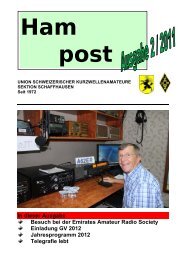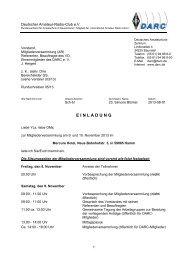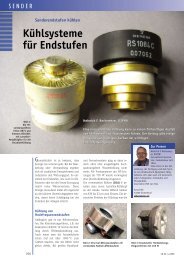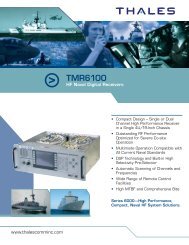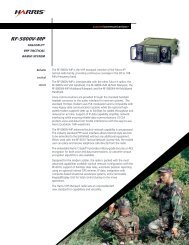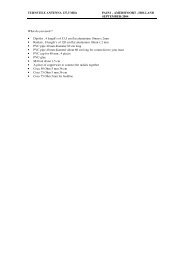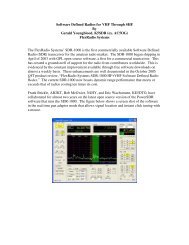MILITARY SOFTWARE DEFINED RADIOS â ROHDE ... - QSLNET.de
MILITARY SOFTWARE DEFINED RADIOS â ROHDE ... - QSLNET.de
MILITARY SOFTWARE DEFINED RADIOS â ROHDE ... - QSLNET.de
Create successful ePaper yourself
Turn your PDF publications into a flip-book with our unique Google optimized e-Paper software.
<strong>MILITARY</strong> <strong>SOFTWARE</strong> <strong>DEFINED</strong> <strong>RADIOS</strong> –<br />
<strong>ROHDE</strong> & SCHWARZ STATUS AND PERSPECTIVES<br />
Ruediger Leschhorn<br />
(Roh<strong>de</strong> & Schwarz GmbH & Co. KG, Munich, Germany;<br />
ruediger.leschhorn@rsd.roh<strong>de</strong>-schwarz.com)<br />
Boyd Buchin<br />
(Roh<strong>de</strong> & Schwarz GmbH & Co. KG, Munich, Germany;<br />
boyd.buchin@rsd.roh<strong>de</strong>-schwarz.com)<br />
ABSTRACT<br />
Roh<strong>de</strong> & Schwarz is one of the leading manufacturers of<br />
radios for the military market with an international<br />
presence in the fields of test and measurement,<br />
information technology and communications. Being<br />
among the first to have <strong>de</strong>veloped Software Defined<br />
Radios Roh<strong>de</strong> & Schwarz today has a family of SDRs in<br />
the market for airborne, tactical/mobile and<br />
stationary/shipborn applications. A review of the current<br />
status will be given in the second chapter of this article.<br />
Germany and many other European nations have<br />
<strong>de</strong>veloped new military operational concepts to meet<br />
challenges yet to come. For their implementation they will<br />
require advanced communication capabilities. The<br />
European requirements for the next generation of<br />
Software Defined Radios are currently un<strong>de</strong>r<br />
<strong>de</strong>velopment. Chapters three and four give insight into<br />
which requirements are to be expected and how these<br />
requirements can be fulfilled by the industry un<strong>de</strong>r the<br />
aspect of today’s expertise and capabilities, and pointing<br />
out migration paths for existing SDRs and concepts for<br />
integrating the new features.<br />
1. INTRODUCTION<br />
The Software Defined Radio concept has been un<strong>de</strong>r<br />
consi<strong>de</strong>ration on a broa<strong>de</strong>r basis for more than 10 years.<br />
After a phase of experimentation and <strong>de</strong>monstrator<br />
programs SDRs have now finally reached the market (e.g.<br />
the R&S ® M3xR family). The <strong>de</strong>velopment programs<br />
behind these SDRs and the experience fielding large<br />
SDR-based communications systems have brought the<br />
expertise to industry required to <strong>de</strong>velop the next<br />
generation of SDRs.<br />
At the time the R&S ® M3xR <strong>de</strong>velopment project<br />
started, there were only few experts worldwi<strong>de</strong> that had a<br />
clear notion of what Software Defined Radio would look<br />
like. In the mean time there are several <strong>de</strong>finitions of<br />
Software Defined Radios covering different advantages of<br />
the SDR concept.<br />
The FCC (Fe<strong>de</strong>ral Communications Commission) and<br />
ITU (International Telecommunications Union) for<br />
instance <strong>de</strong>fine that SDRs are characterized by the<br />
possibility to change frequency, modulation and output<br />
power via software.<br />
The SDR Forum, which today is the most important<br />
community to treat all technical, commercial and<br />
regulatory aspects of SDRs, gives a more stringent<br />
<strong>de</strong>finition. In the essence the forum requires an SDR to<br />
provi<strong>de</strong> software control of a variety of modulation<br />
techniques, wi<strong>de</strong>-band or narrow-band operation,<br />
communications security functions (such as frequency<br />
hopping), and waveform requirements of current and<br />
evolving standards over a broad frequency range. An SDR<br />
shall be capable of storing a large number of waveforms<br />
and of adding new ones via software download.<br />
A further approach is to <strong>de</strong>fine SDRs as radios having<br />
an architecture that is in alignment with the Software<br />
Communications Architecture (SCA). The SCA is a US<br />
DoD standard that is closely related to the US JTRS<br />
project.<br />
All these different <strong>de</strong>finitions are justified from their<br />
respective point of view. The Roh<strong>de</strong> & Schwarz M3xR<br />
family of Software Defined Radios is characterized by<br />
software control, wi<strong>de</strong> operational frequency range,<br />
extensive digital signal processing, and the ability to store<br />
several waveforms and download new ones. Consequently<br />
they fulfill the SDR Forum’s <strong>de</strong>finition of an SDR.<br />
2. <strong>SOFTWARE</strong> <strong>DEFINED</strong> <strong>RADIOS</strong> IN THE FIELD –<br />
THE R&S ® M3XR FAMILY<br />
Proceeding of the SDR 04 Technical Conference and Product Exposition. Copyright © 2004 SDR Forum. All Rights Reserved
2.1. Overview<br />
The radios of the R&S ® M3xR family are based on the<br />
same technology platform. It uses similar processor<br />
families for the respective tasks within the radio, e.g.<br />
human-machine interface (HMI), radio control, digital<br />
signal processing, and protection processing units as far as<br />
this is viable. The technology platform provi<strong>de</strong>s an<br />
architectural framework that is comparable to the Joint<br />
Tactical Radio System/Software Communications<br />
Architecture (JTRS/SCA) and eases the scalability of the<br />
radio and the portability of software functions across the<br />
Fig. 2: Modularity of the R&S ® M3AR<br />
Fig. 1: R&S ® M3AR (Multiband, Multimo<strong>de</strong>,<br />
Multirole Airborne Radio)<br />
different members of the family.<br />
The R&S ® M3xR Technology Platform provi<strong>de</strong>s a<br />
sound basis for the three members of the Roh<strong>de</strong> &<br />
Schwarz SDR family, which are used for various<br />
applications and roles in the armed forces. As these<br />
applications put different emphasis on the operational<br />
requirements, e.g. wi<strong>de</strong> temperature range, lowest<br />
possible power consumption, or high flexibility, the<br />
members of the family are optimized accordingly.<br />
2.2. The Airborne Radio R&S ® M3AR<br />
The R&S ® M3AR was <strong>de</strong>signed focusing on two tenets:<br />
First, the radio should be able to replace the ARC-164,<br />
which is a <strong>de</strong>vice used onboard of many aircraft all over<br />
the world and which is of remarkably small size. Second,<br />
the radio should be able to download and provi<strong>de</strong> mo<strong>de</strong>rn<br />
EPM waveforms, both for the NATO market and the<br />
world market.<br />
Airborne radios have stringent requirements in terms<br />
of environmental conditions, size and technical<br />
performance. To meet these high <strong>de</strong>mands airborne radios<br />
have to be optimized with the Technology Platform as a<br />
basis. The main <strong>de</strong>sign goals for the <strong>de</strong>velopment of the<br />
R&S ® M3AR have therefore been:<br />
• Retrofit of the type ARC 164 radios (form, fit and<br />
function)<br />
• Minimum size and lowest weight<br />
• Housing ARINC ATR 600 as an option<br />
• Operational performance temperature range -54°C to<br />
+71°C<br />
• High reliability<br />
• Software reprogrammable<br />
The VHF/UHF Transceiver features a modular <strong>de</strong>sign<br />
based on the following modules (see also Fig. 2):<br />
• Chassis compatible to ARC- 164<br />
• Control Panel<br />
• Protection Processor to perform advanced waveforms<br />
(TRANSEC and COMSEC)<br />
• Synthesizer<br />
• Receiver including guard receivers<br />
• Transmitter Control<br />
• Amplifier<br />
• Power Supply<br />
• Interface<br />
• Radio Control<br />
The frequency ranges covered are the UHF range<br />
(225 – 400 MHz), the upper VHF range from 108 MHz to<br />
174 MHz as well as the lower VHF range from 30 MHz to<br />
88 MHz.<br />
Today several waveforms are provi<strong>de</strong>d e.g.<br />
R&S ® SECOS (a fast frequency hopping system with<br />
Proceeding of the SDR 04 Technical Conference and Product Exposition. Copyright © 2004 SDR Forum. All Rights Reserved
Fig. 3: R&S ® M3SR (Multiband, Multimo<strong>de</strong>,<br />
Multirole Stationary Radio)<br />
Fig. 4: R&S ® M3SR outline<br />
embed<strong>de</strong>d COMSEC functionality), NATO-Have Quick<br />
I/II and NATO-SATURN.<br />
2.3. The Stationary/Shipborne Radio R&S ® M3SR<br />
The R&S ® M3SR, Fig. 3, is a modular, multimo<strong>de</strong> and<br />
multirole radio, <strong>de</strong>veloped for civil/military ATC, air<br />
<strong>de</strong>fense and naval operations. Applicable platforms are<br />
ships, ground stations, shelters and special aircraft like<br />
AEW (Airborne Early Warning). Different variants are<br />
available by using a basic radio equipped with selected<br />
options. Potential military applications inclu<strong>de</strong> navy, air<br />
<strong>de</strong>fense, military air traffic control and land mobile.<br />
Today it is available for the VHF/UHF frequency range<br />
100 MHz to 512 MHz.<br />
Air <strong>de</strong>fense typically requires secure and<br />
electronically protected communication. Usually<br />
frequency hopping methods are used as Electronic<br />
Protection Measures (EPM). There are EPM-mo<strong>de</strong>s with<br />
slow, medium and fast hop rates, <strong>de</strong>pending on frequency<br />
range and standard used.<br />
Naval forces today are using the UHF range with<br />
EPM and various link methods for ship-ship and shipshore<br />
communications.<br />
During the <strong>de</strong>finition and <strong>de</strong>sign of the R&S ® M3SR<br />
emphasis was set on high modularity, flexibility,<br />
extensibility and performance. These are the prerequisites<br />
for true multiband, multimo<strong>de</strong> and multirole capabilities<br />
and can realistically only be implemented using the<br />
software <strong>de</strong>fined radio approach.<br />
The R&S ® M3SR has a well structured extremely<br />
flexible modular <strong>de</strong>sign. It consists of a powerful radio<br />
basis (comparable to the motherboard in the PC-world)<br />
which can accommodate several modules. To keep<br />
maintenance to a minimum, the individual radio modules<br />
are fully in<strong>de</strong>pen<strong>de</strong>nt of each other. If an individual<br />
module is replaced, no hardware adjustments of the radio<br />
basis are required.<br />
Based on an embed<strong>de</strong>d real-time operating system,<br />
the radio basis handles internal communication, the<br />
interfaces to the outsi<strong>de</strong> world and takes care of audio<br />
signal processing as well as radio control. Waveform<br />
modifications or additional data radio protocols can be<br />
implemented by software downloads. The user can thus<br />
create flexible radio systems from hardware and software<br />
building blocks.<br />
Besi<strong>de</strong>s the radio basis the R&S ® M3SR consists of<br />
various modules to establish different radio configurations<br />
(see Fig. 4): e.g. receiver and guard receiver modules,<br />
synthesizer and filter modules, waveform processor<br />
modules and interface cards.<br />
For software download a TCP/IP interface is used. A<br />
protocol for the download process has been <strong>de</strong>veloped to<br />
cope with critical download issues like error-free and<br />
secure co<strong>de</strong> transfer, configuration management and<br />
authorization.<br />
2.4. The Tactical Radio R&S ® M3TR<br />
The R&S ® M3TR is <strong>de</strong>signed for use with military and<br />
civil waveforms, both legacy and new ones.<br />
The multirole features of a Software Defined Radio<br />
are <strong>de</strong>termined by its ease of integration into tactical<br />
communication networks.<br />
The radio can be used for different applications either<br />
as a manpack, in vehicular mount or in stationary<br />
installations. With its functionality the radio can perform<br />
the tasks of the participating units in a Mobile Sub-System<br />
such as Combat Net Radio (CNR), Packet Radio Net<br />
(PRN), Repeater (Range Extension No<strong>de</strong>, REN), Radio<br />
Access Point (RAP) or gateway between different nets in<br />
different frequency bands.<br />
Proceeding of the SDR 04 Technical Conference and Product Exposition. Copyright © 2004 SDR Forum. All Rights Reserved
Fig. 5: R&S ® M3TR (Multiband, Multimo<strong>de</strong>,<br />
Multirole Tactical Radio)<br />
The R&S ® M3TR offers high data rates of up to 72<br />
kbps for real-time data and vi<strong>de</strong>o transfer as well as an<br />
Internet/Intranet access via the integrated Ethernet<br />
interface.<br />
Especially when used as a manpack tactical radio,<br />
extremely high <strong>de</strong>mands exist in terms of power<br />
consumption and weight. Other <strong>de</strong>sign consi<strong>de</strong>rations are<br />
miniaturization, flexibility and system capability.<br />
In or<strong>de</strong>r to optimize the radio in RF performance the<br />
R&S ® M3TR manpack was <strong>de</strong>signed in two versions. One<br />
version covers the HF and the lower VHF frequency<br />
range (1.5 MHz up to 108 MHz), the other the VHF and<br />
the UHF range (25 MHz up to 512 MHz). The two<br />
versions differ only in the TX amplification capabilities.<br />
So, with just two manpack versions, the R&S ® M3TR<br />
transceiver covers the whole spectrum from short wave<br />
through to the UHF band. On top of this with the vehicle<br />
version only one R&S ® M3TR with external power<br />
amplifiers is necessary for the frequency range 1.5 MHz<br />
up to 512 MHz.<br />
Besi<strong>de</strong>s this outstanding multiband capability the<br />
power consumption and versatility are among the most<br />
important features for a tactical radio product. The<br />
architecture of the R&S ® M3TR was <strong>de</strong>signed to meet<br />
these requirements.<br />
The Tactical Radio R&S ® M3TR consists of the<br />
following main modules:<br />
• Radio Controller<br />
• Protection Processor (optional)<br />
• Power Amplifier VHF/UHF or HF/VHF-FM with<br />
integrated Antenna Tuning Unit<br />
• RF Unit<br />
• Power Supply<br />
The Radio Controller is the central control module of<br />
the R&S ® M3TR. It controls the entire radio and handles<br />
all user voice and data services supported by several links<br />
interfaces to the radio components.<br />
The computing <strong>de</strong>vices of the R&S ® M3TR inclu<strong>de</strong><br />
one central general purpose processor, several DSPs and a<br />
security processor, interlinked and initialized by FPGAs.<br />
The storage capacity allows up to 99 <strong>de</strong>fault settings<br />
(preset pages), including several Electronic Protection<br />
Measure (EPM) methods, to be stored simultaneously.<br />
The preset pages contain all the variable parameters of the<br />
selected waveform, such as hopsets, modulation mo<strong>de</strong>s<br />
and addressing.<br />
The Power Amplifier amplifies the transmit signal<br />
and filters out unwanted harmonics. The internal Antenna<br />
Tuning Unit as a part of the power amplifier is responsible<br />
for antenna matching. In receive mo<strong>de</strong> the harmonic<br />
filters increase the image rejection and improve the<br />
preselection performance.<br />
The Radio Frequency Unit (RFU) is divi<strong>de</strong>d into two<br />
main sections: the Front-end and the Synthesizer rejection<br />
mixers. The front-end is mainly composed of input image<br />
and IF rejection filters, mixers, channel filters, amplifiers,<br />
and the automatic gain control, AGC. In receive mo<strong>de</strong> the<br />
incoming signal is low pass filtered for HF (1.5 to 30<br />
MHz) or tuned band pass filtered for VHF/UHF and<br />
digitally mixed down to IF.<br />
The synthesizer, controlled by means of a reference<br />
clock oscillator, supplies all local oscillator signals of the<br />
radio, e.g. all mixer frequencies.<br />
The Power Supply Module has to <strong>de</strong>liver the required<br />
voltages with very high efficiency, since this <strong>de</strong>termines<br />
significantly the power dissipated in the radio and thus the<br />
operational lifetime between two battery charges. It<br />
consists of synchronized low distortion-DC/DCconverters<br />
to <strong>de</strong>liver the supply voltages, the high-si<strong>de</strong>switch<br />
for power-on and filters for the supply voltages.<br />
EMC-filters are provi<strong>de</strong>d for all power and control lines<br />
to the rear power supply connector.<br />
The presented radios have been already <strong>de</strong>livered in<br />
larger quantities to international customers. Among others<br />
there are customers in Europe, America (e.g. Brazil), Near<br />
East and Far East.<br />
3. UPCOMING EUROPEAN REQUIREMENTS<br />
Even though Software Defined Radios are by far more<br />
versatile than radios of previous generations, differences<br />
in <strong>de</strong>sign will be required to be able to meet the specific<br />
needs of each customer.<br />
One example is the US JTRS program, where the US<br />
military users have laid down their requirements in great<br />
<strong>de</strong>tail and are constantly refining them. These<br />
requirements meet the <strong>de</strong>mands of the US <strong>de</strong>fense strategy<br />
and its goal to transform the US forces transformation into<br />
the information age. The un<strong>de</strong>rlying concept is known as<br />
Proceeding of the SDR 04 Technical Conference and Product Exposition. Copyright © 2004 SDR Forum. All Rights Reserved
Network-Centric Warfare. The key focus is to provi<strong>de</strong> the<br />
US forces with a significant advantage by robustly<br />
networking them. This task requires upgra<strong>de</strong>able highperformance<br />
network radios providing joint and combined<br />
interoperability.<br />
What is called Network-Centric Warfare in the US<br />
has its counterparts in European countries like the United<br />
Kingdom, France, Swe<strong>de</strong>n, Finland and Germany. Among<br />
the <strong>de</strong>signations used are “Network Enabled Capabilities”<br />
(United Kingdom), “Network Based Defence” (Swe<strong>de</strong>n)<br />
and “Vernetzte Operationsführung” (Germany). The<br />
concepts and their implementation are similar but not<br />
i<strong>de</strong>ntical.<br />
Concerning the radio part of the concepts there are<br />
many common requirements. The among the most<br />
important are multimo<strong>de</strong>, multirole and multiband<br />
capability, interoperability with all services, partners and<br />
security forces, the need for multiple channels and high<br />
data-rates and extensive network capabilities based on IP<br />
(IPv6).<br />
The main differences between the European and US<br />
requirements are for one the waveforms selected for<br />
implementation. The reasons for the different waveform<br />
priorities are evi<strong>de</strong>nt: On the one hand there are a number<br />
of national and proprietary waveform solutions like<br />
PR4G, SEM93 and SECOS fiel<strong>de</strong>d in many thousands of<br />
units. Interoperability with this legacy equipment is<br />
essential as a large amount of it will remain in service for<br />
many years to come. On the other hand the US<br />
government and a number of companies have intellectual<br />
property rights on the waveforms selected for<br />
implementation in the US JTRS program – both a<br />
hindrance on the path to multi-national interoperability.<br />
Further important differences concern transmission<br />
security, crypto and crypto policy. Nearly every nation<br />
has its own solutions and a large portion of the fiel<strong>de</strong>d<br />
units are not capable of additionally supporting an<br />
interoperable NATO standard. As national security is an<br />
important issue it seems unlikely that the requirements for<br />
national solutions will be dropped.<br />
These are by far not the only relevant security issues<br />
for nations formulating their SDR requirements: The high<br />
flexibility of SDRs, which is a <strong>de</strong>sirable feature as far as<br />
waveforms are concerned, in principal opens the<br />
possibility to compromise the radio by modifying its<br />
functionality – much the same way as a virus modifies the<br />
behavior of a personal computers. To counter this<br />
possibility, stringent supervision of the software and its<br />
status are indispensable. This inclu<strong>de</strong>s the protection<br />
against unauthorized access to the software installed and<br />
thorough investigation (e.g. by co<strong>de</strong> inspection) of third<br />
party software.<br />
Apart from these differences most of the European<br />
programs have requirement similar to those of the US<br />
JTRS program. Examples for such similarities are<br />
multiband functionality, switching between waveforms<br />
during operation and software download. These<br />
requirements – as well as many others – are already<br />
covered by the fiel<strong>de</strong>d R&S ® M3xR SDR-family.<br />
4. MIGRATION TO FUTURE ARCHITECTURES<br />
Though Software Defined Radio still is a new and<br />
exciting technology there is an industry history behind.<br />
Demonstrators like SpeakEasy, PDR, and MMR/ADM as<br />
well as early products with software-<strong>de</strong>fined<br />
functionalities started this history. The current generation<br />
of Software Defined Radios has left the experimentation<br />
phase, is now fiel<strong>de</strong>d in military and commercial systems,<br />
and provi<strong>de</strong>s full SDR functionality. An example is the<br />
R&S ® M3xR family. This is where industry is today.<br />
The next generation of SDRs is being <strong>de</strong>veloped right<br />
now in different countries on both si<strong>de</strong>s of the Atlantic.<br />
The salient characteristics of this new generation will be<br />
their harmonized radio architecture inclu<strong>de</strong>s a Hardware<br />
Abstraction Layer (HAL). The transition from the today’s<br />
SDRs to the next generation can be a graceful one in<br />
many respects, since the majority of mechanisms of the<br />
common architecture of the next generation have already<br />
been foreseen and integrated into the current generation.<br />
One example is the Hardware Abstraction Layer.<br />
During the <strong>de</strong>velopment of the R&S ® M3xR SDR-family<br />
the importance of having such a layer became obvious.<br />
Thus abstraction mechanisms were inclu<strong>de</strong>d, similar to<br />
those <strong>de</strong>fined in the current US JTRS program.<br />
The Migration to this third generation will inclu<strong>de</strong> the<br />
implementation of further advanced waveforms providing<br />
high data rates and networking capabilities. This will<br />
require significantly higher processing power and an<br />
adapted front-end, as the carrier frequency and the<br />
bandwidth will increase significantly.<br />
Roh<strong>de</strong> & Schwarz with its proven experience in SDR<br />
technology, mobile communications systems networks<br />
and high data rate transmission has the i<strong>de</strong>al prerequisites<br />
to tackle tomorrow’s challenges.<br />
Proceeding of the SDR 04 Technical Conference and Product Exposition. Copyright © 2004 SDR Forum. All Rights Reserved




